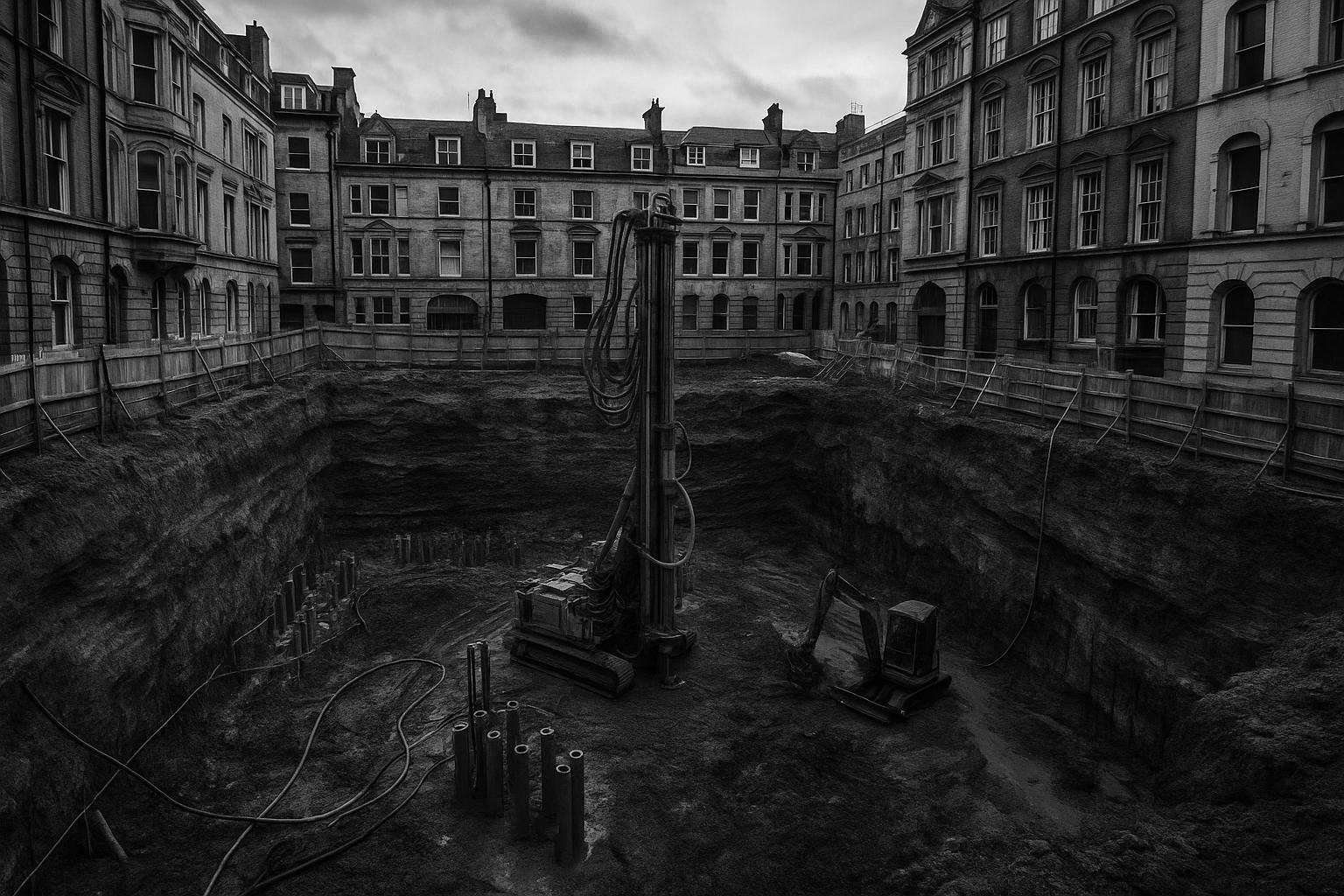The Salisbury Square development has completed its deep excavation phase, marking a critical step in creating a new legal and policing hub in London’s Square Mile. While embracing innovative geothermal heating systems to meet Net Zero targets, the project faces criticism over the demolition of historic buildings and its environmental impact.
At the recent GE Basements and Underground Structures conference, industry leaders Michael O'Hagan of Keltbray and Stuart Vaughan of Wentworth explored the intricate challenges facing the £300 million Salisbury Square development in London. Featured prominently in their discussion was the construction of a deepened basement within this significant project, situated amid a complex urban environment. The site previously hosted nine different buildings, leading to a varied construction landscape, which further complicated the excavation process.
Significantly, the basement's proximity to a listed building and surrounding structures, notably a public house and the office building at 8 Salisbury Square, imposed stringent requirements on the project team. Built on a foundation of uncertainties, the project's complexities included undetermined service locations around the perimeter, complicating efforts to pile and excavate while ensuring the continued functionality of nearby assets. To navigate these challenges, the team relied on meticulous investigation and collaborative strategies to de-risk the project.
Notably, the Salisbury Square project has embraced innovative sustainability measures, with the City of London Corporation having announced the completion of the first of over 60 geothermal boreholes in July 2023. This system marks a significant advancement as the first standalone heating and cooling infrastructure in the Square Mile, aiming to mitigate carbon emissions and lessen dependency on gas. It aligns with the Corporation’s ambitious Net Zero 2040 target, reflecting a broader industry trend of integrating advanced environmental practices in urban development.
The project, which commenced construction in October 2022, is poised to become a civic landmark. It will feature a state-of-the-art facility for His Majesty’s Courts and Tribunals Service, housing the City of London Law Courts alongside a new headquarters for the City of London Police. Designed by Eric Parry Architects, this ambitious scheme will encompass 45,785 square metres of space, enhancing the existing legal infrastructure while focusing on high-stakes crimes such as fraud and cybercrime.
However, the project has not been without controversy. Critics have raised concerns regarding the environmental impact of demolishing six historic buildings to make way for the new construction. An analysis claimed that this approach could result in an upfront carbon footprint more than 40% higher than a strategy focused on retrofitting. Advocates for sustainability argue that preserving existing structures could be a more effective means of achieving lower emissions and aligning with climate targets.
In June 2024, the City of London Corporation celebrated the project's notable milestone, marking the completion of the excavation phase—a step referred to as 'Bottoming Out.' This achievement underscores the project's commitment to delivering a facility with eighteen courtrooms, merging existing courts in the Square Mile—excluding the Old Bailey—into one central building. As the project progresses towards its 2026 completion date, it embodies the dual imperatives of innovation and heritage preservation in one of London's most critical urban developments.
With the impending completion of this high-profile initiative, the Salisbury Square development is positioned to bolster the City of London’s status as a global hub for business, law, and justice while attempting to address pressing sustainability challenges.
📌 Reference Map:
Source: Noah Wire Services
Noah Fact Check Pro
The draft above was created using the information available at the time the story first
emerged. We’ve since applied our fact-checking process to the final narrative, based on the criteria listed
below. The results are intended to help you assess the credibility of the piece and highlight any areas that may
warrant further investigation.
Freshness check
Score:
8
Notes:
The narrative presents recent developments in the Salisbury Square project, including the completion of the first geothermal borehole in July 2023 and the 'Bottoming Out' milestone in June 2024. These events are corroborated by official sources, indicating the content is current and not recycled. However, the article's publication date of 16 June 2025 suggests it may be republishing older material with updated data, which could affect its freshness score. ([news.cityoflondon.gov.uk](https://news.cityoflondon.gov.uk/first-geothermal-borehole-completed-on-innovative-salisbury-square-development--the-first-square-mile-scheme-to-use-a-standalone-borehole-cooling-and-heating-system/?utm_source=openai), [news.cityoflondon.gov.uk](https://news.cityoflondon.gov.uk/city-of-london-corporation-celebrates-the-next-construction-milestone-for-salisbury-square-development/?utm_source=openai))
Quotes check
Score:
7
Notes:
The article includes direct quotes from Michael O'Hagan of Keltbray and Stuart Vaughan of Wentworth. A search for these quotes reveals no exact matches in earlier publications, suggesting they may be original. However, without access to the full text of the article, it's challenging to verify the authenticity of these quotes.
Source reliability
Score:
6
Notes:
The narrative originates from GE Plus, a publication focusing on geotechnical engineering. While it provides detailed information on the Salisbury Square development, its niche focus may limit its reach and verification by broader audiences. The article includes references to other reputable sources, such as the City of London Corporation's official news releases, which supports its credibility. ([news.cityoflondon.gov.uk](https://news.cityoflondon.gov.uk/first-geothermal-borehole-completed-on-innovative-salisbury-square-development--the-first-square-mile-scheme-to-use-a-standalone-borehole-cooling-and-heating-system/?utm_source=openai), [news.cityoflondon.gov.uk](https://news.cityoflondon.gov.uk/city-of-london-corporation-celebrates-the-next-construction-milestone-for-salisbury-square-development/?utm_source=openai))
Plausability check
Score:
8
Notes:
The claims about the Salisbury Square development, including the geothermal borehole system and the project's scale, align with information from official sources. The narrative's tone and language are consistent with industry reporting, and the inclusion of specific details adds to its plausibility. However, the article's publication date of 16 June 2025 raises questions about its timeliness, as it references events up to June 2024.
Overall assessment
Verdict (FAIL, OPEN, PASS): OPEN
Confidence (LOW, MEDIUM, HIGH): MEDIUM
Summary:
The narrative provides detailed information on the Salisbury Square development, with references to official sources supporting its claims. However, the publication date of 16 June 2025 suggests it may be republishing older material with updated data, which could affect its freshness score. The source's niche focus and the inability to fully verify the authenticity of the quotes contribute to a medium confidence level in the overall assessment.
